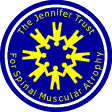The Jennifer Trust for Spinal Muscular Atrophy
 |
Genetic Studies in Distal
|
 |
Genetic Studies in Distal
|
No disease genes have been identified in the other types of SMA, this includes distal SMA (often called progressive muscular atrophy or spinal Charcot-Marie-Tooth disease) and late-onset adult SMA. The lack of discovered genes means our knowledge of these types of SMA is far less than the childhood onset proximal SMAs. I recently received a 3 year grant from The Wellcome Trust to investigate the genetic causes of distal SMA. The research is being carried out at The National Hospital for Neurology and Neurosurgey working with Professor PK Thomas, Dr. Mary Reilly and Dr. Nicholas Wood.
Although much clinical and genetic heterogeneity exists among SMAs they all demonstrate progressive weakness and muscle atrophy from anterior horn cell (specific nerve cells in the spinal cord) degeneration. The SMAs are classified according to the age of first symptoms, mode of inheritance, distribution of weakness and rate of progression. Clinically these disorders all demonstrate limb weakness and muscle wasting. Sensory abnormalities are absent in SMA. Along with an examination by a neurologist, nerve conduction studies and EMG (electrical tests on the nerves and muscles) and muscle biopsy are diagnostic in SMA patients.
The most common form of SMA is the childhood onset proximal type with an incidence of 1 in 10000 newborns. These have been divided into three types according to age at first symptoms and milestones of development. Type I SMA is the severe form of Werdnig-Hoffmann disease with onset at birth or before 6 months and are never able to sit or walk due to profound muscular weakness. Children with type II SMA can sit but cannot stand or walk unaided. Type III SMA (Kugelberg-Welander disease) patients show the first clinical signs after 18 months, evolving to a chronic course.
Distal SMA is less common but still accounts for about 10% of all cases of SMA. Juvenile (disease onset before 20 years) and adult (onset 20 between 40 years) forms are the commoner types to occur. Clinically patients usually present with difficulty walking, running and doing sports due to lower limb weakness and prominent wasting of the calf, ankles and small muscles of the feet. Weakness and wasting of the upper limbs also occurs particularly in the wrists and small muscles of the hands. Back and foot deformities are also present in a quarter of SMA patients. Some patients also have problems with vocal cord paralysis and have a hoarse voice but this is rare. The progression of distal SMA is slow. Inheritance is usually autosomal dominant with one copy of the defective gene being needed to have the disease; this can be inherited from the patient's mother or father, often with several members of the family suffering from distal SMA. Autosomal recessive inheritance is rare with two copies of the defective gene being needed to have the disease; one from the patients mother and one from the father. No disease genes have been identified in distal SMA. Hence, our knowledge of why the spinal cord neurones that control muscles to the feet and hands degenerate and how to reduce or stop this from occurring in distal SMA is much less than in SMA where the disease gene is known.
Initially in our study we are collecting families where two or more individuals are affected by distal SMA. We hope to obtain family details through patients themselves by contacting me at The National Hospital. All family details are private and confidential. For our study we require a small sample of blood from affected and unaffected family members. This sample can either be taken by an individual's GP, or more ideally, I can arrange for families to come to our research clinic at The National Hospital for Neurology (our grant will pay for transport) for full examination and investigations. I can also visit families at home in order to examine as many family members as possible and take their blood.
The goal of our research is to find the cause of the different types of distal SMA, this will accelerate our understanding of the mechanism of anterior horn cell degeneration and muscle loss and thus lead to the discovery of drugs that stop, reduce or ideally reverse the disease process. Without the help of families our research would not be possible.
I would be most grateful if any family members could contact me at the address or phone numbers below if they can help with our research.
| Dr. Henry Houlden, Research Fellow Neurogenetics Laboratory The National Hospital for Neurology and Neurosurgery Queen Square London, WC1N 3BG. UK.
Tel: 0171 837 3611 x3936 |
HTML by DanE
First published by The Jennifer Trust for Spinal Muscular Atrophy : 1st June 1999
Latest update : 1st June 1999